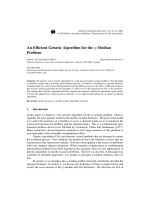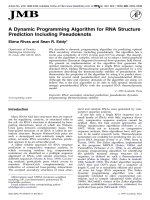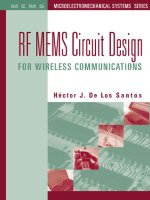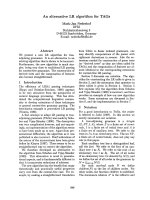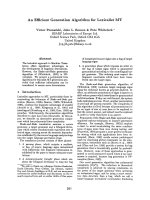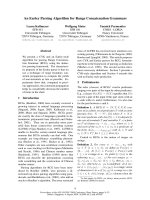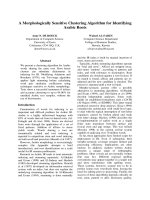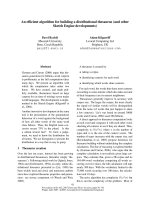an energy-based clustering algorithm for wireless
Bạn đang xem bản rút gọn của tài liệu. Xem và tải ngay bản đầy đủ của tài liệu tại đây (630.62 KB, 6 trang )
An Energy-based Clustering Algorithm for Wireless
Sensor Networks
Jin Wang
1
, Xiaoqin Yang
1
, Yuhui Zheng
1
, Jianwei Zhang
2
, Jeong-Uk Kim
3
1
Jiangsu Engineering Center of Network Monitoring, Nanjing University of Information
Science & Technology, Nanjing 210044, China
2
School of Math and Statistic, Nanjing University of Information Science & Technology,
Nanjing 210044, China
3
Department of Energy Grid, Sangmyung University, Seoul 110-743, Korea
{wangjin, xqyang, yhzheng, zhangjw}@nuist.edu.cn;
Abstract. Energy efficient routing is one of the key issues to prolong lifetime
of wireless sensor networks (WSNs). The number of cluster and the distribution
of cluster heads (CHs) have a major impact on the network performance.
Energy-based clustering algorithm can greatly improve energy efficiency of
WSNs because it adopts a multi-hop communication in each cluster. Besides,
the neighborhood of the sink node (SN) will perform direct transmission to
relieve the workload of CHs. Simulation results show that our algorithm can
largely reduce the total energy consumption and prolong the network lifetime
compared to other algorithm like LEACH.
Keywords: wireless sensor networks, energy level, cluster number, clustering
1 Introduction
Wireless sensor networks (WSNs) are composed of large number of low-cost and
tiny sensors. It is a distributed and self-organized network where sensor nodes will
locally carry out sensing, processing and transmitting operations in an autonomous
and unattended manner. WSNs have broad applications such as military surveillance
and tracking, environment monitoring and forecasting, healthcare etc.[1,2].
Energy consumption and energy-balancing are one of the primary research issues
for WSNs. Since node’s energy is limited and non-rechargeable, how to improve
energy efficiency and balance energy has become more and more important.
Clustering algorithm is an energy-efficient technology for WSNs. In practice, CHs
can process, filter and aggregate data sent by cluster members. In this paper, we focus
on studying the influence of cluster number on network performance. We propose an
Energy-based Clustering Algorithm (ECA) for WSNs. Based on [6], we discuss the
overall energy consumption under different numbers of clusters and get the optimal
cluster number. Then we divide the sensor field into k equal regions where we choose
nodes with the highest residual energy as CHs and adopt multi-hop manner to
transmit data. Thus, we can ensure uniform distribution of CHs in entire network and
relieve the workload of CHs.
16
2 Related Work
Directed diffusion (DD)[3] is a query-based routing protocol for WSNs. By using
data aggregation, caching and reinforcement techniques, the appropriate link is
dynamically selected from the candidates. Rumor routing protocol [4] uses
forwarding query messages randomly to reduce the overhead of route establishment.
Hierarchical structure routing protocols are suitable for WSNs since they can not
only provide good scalability but also perform data aggregation. Low-energy adaptive
clustering hierarchy (LEACH)[5] is a clustering-based protocol which utilizes
randomized rotation of local CHs to evenly distribute the energy load across the
network. Compared with other ordinary routing protocols like DD, it can prolong the
network lifetime up to 8 times. However, the 5% of CHs are randomly selected and
CHs transmit data directly to SN. To address this deficiency, LEACH-C algorithm [6]
centralize to choose CHs through the sink nodes. Power-Efficient gathering in sensor
information systems (PEGASIS)[7] is known as an improved version of LEACH. It
uses chain structure to connect and select the nearest neighbor to communicate.
Besides, each chain selects only one node as the head communicating with SN. A
hybrid, energy-efficient, distributed (HEED)[8] clustering protocol was proposed
which considers node’s residual energy and the cost of communication within the
cluster during CHs selection. It can not only minimize the control overhead, but also
prolong network lifetime since CHs are well distributed.
The author in [9] introduced an energy efficient heterogeneous clustered scheme
based on weighted election probabilities of each node to become CHs according to the
residual energy. The author in [10] introduced an adaptive decentralized re-clustering
protocol (ADRP). In ADRP, CHs and next heads are elected on residual energy of
each node and the average energy of each cluster. The author in [11] proposed a novel
distributed clustering algorithm where CHs are elected following a three-way
message exchange between each sensor and its neighbors. Sensor’s eligibility to be
elected cluster head is based on its residual energy and its degree. To enhance lifetime,
the author in [12] proposed an energy efficient clustering protocol (EECPL) which
organizes sensors into clusters and uses ring topology to send data packets. In [13],
the author proposed a hop-based energy aware routing algorithm to save and balance
energy consumption.
3 Energy Consumption and Optimal Cluster Number
We adopted the energy consumption model which is called first order radio model.
The definitions and units of radio parameters are listed in Table 1.
Table 1. Radio parameters.
Parameter Definition Unit
elec
E Energy dissipation to run the radio device 50 nJ/bit
fs
ε
Free space model of transmitter amplifier 10 pJ/bit/m
2
17
mp
ε
Multi-path model of transmitter amplifier 0.0013 pJ/bit/m
4
l
Packet length 2000 bits
0
d Distance threshold
mpfs
εε
m
Each node consumes the following
Tx
E amount of energy to transmit an l-bits
message over distance d and the
Rx
E amount of energy to receive the message.
{
0
2
0
4
,
,
),(
dddllE
dddllE
Tx
fselec
mpelec
dlE
<+
≥+
=
ε
ε
;
elecRx
lElE
=
)(
(1)
According to first order radio model, each cluster consumes the
cluster
E amount
of energy to communicate with SN. To minimize the total energy consumption
total
E ,
we use the conclusion in [10] to get the optimal cluster number
opt
k and the formula is
shown as the follows.
k
N
k
R
llEE
k
N
lEE
k
N
EE
fselecTxelecmemberCHcluster
)
2
()1()1(
2
ε
+++−≈−+=
(2)
k
R
NlKElkENlENEkEkEE
fsTxelecelecmemberCHclustertotal
2
2
2
ε
++−=+==
(3)
mp
fs
opt
N
d
R
k
ε
ε
2
2
=
(4)
4 Our Proposed Energy-based Clustering Algorithm (ECA)
4.1 Cluster Formation
Before CHs selection, we firstly divide the network into k equal regions according to
the optimal cluster number. Cluster head only manages the data collected from the
region and then relay the aggregated data to SN. Besides, neighbor nodes of SN will
perform direct transmission to SN.
After cluster formation, we assign a random initial energy level to each sensor. To
balance the energy consumption levels, we use the initial energy levels to select the
CH-candidate nodes. Upon being selected, each CH-candidate transmits a packet and
advertises its ID and residual energy level. A CH-candidate monitors advertisements
from others and defers from acting as a CH if a higher energy level is reported by
another. Finally, candidate with the highest residual energy level will become CH.
Other nodes in this region will become the member of this cluster.
18
4.2 Intra-cluster Multi-hop Routing Setup
We adopt a multi-hop communication protocol to save energy and set a threshold d. If
the distance is smaller than d, it transmits data to CHs directly; otherwise, it will find
an adjacent node as the relay node. We choose the relay node based on distance and
residual energy. Suppose
i
s is far away from CHs and chooses
j
s as its relay node.
We adopt a free space propagation channel model to deliver an l-bits packet to CHs.
The energy consumption and the link cost
link
E are defined respectively as follows.
)),(),((3),(
22
CHssdssdllEssE
jjifselecji
++=
ε
(5)
22
),(),(),( CHssdssdssE
jjijilink
+=
(6)
To avoid the nodes near CHs depleting their energy quickly, we also consider the
residual energy of the relay node. So the cost is defined as follows.
]1,0[,
))(max(
)())(max(
)1(
)),(),(max(
),(),(
)(cos
22
22
∈
−
∗−+
+
+
∗=
ωωω
jE
jEjE
CHssdssd
CHssdssd
jt
jji
jji
(7)
After each node has chosen the minimum cost node as its relay node, an intra-
cluster route is constructed.
5 Performance Evaluation
We use MATLAB simulator to evaluate the performance of our algorithm. There are
[200,500] nodes evenly deployed in a [150,200,300] circular area. The initial energy
level of each node is 2J. SN is placed in the centre of the network. The transmission
radius can be adjusted from 80 to 100 meters based on node density.
5.1 Network Topology
According to Formula (4), when N=200 and R=150, k is equal to 16. Fig.1 illustrates
this point that the energy consumption is the least when k=16.
Fig.1. Comparison of energy consumption. Fig.2. Network topology.
19
Then we divide the network into 16 equal regions and select nodes with the highest
residual energy level to act as CHs. The neighborhood of SN has been marked with
stars. The network topology is built as shown in Fig.2.
5.2 Total Energy Consumption and Network Lifetime
Fig.3 shows the energy consumed by ECA and LEACH and ECA consumes less
energy than LEACH so that we can achieve the goal to save energy. Besides, the
number of “Alive node” in one region over simulation time is illustrated in Fig.4.
Here, we define the network lifetime as the period of time until the first node depletes
its energy. Fig.5 shows that the lifetime of ECA in one region is around 2087 rounds,
whereas the lifetime of LEACH is around 1478 rounds. Thus ECA has a better
performance in extending network lifetime.
Fig.3. Energy consumption. Fig.4. Network lifetime.
6 Conclusions
In this paper, energy-based clustering algorithm (ECA) is proposed to reduce the
energy consumption. In ECA, we compare the overall energy consumed by the
network with different cluster number. And then we divide the network and assign an
initial energy level to each node. In each region, we select the node with highest
residual energy level from the candidate nodes to act as cluster head. In each cluster,
we adopt a multi-hop communication protocol between cluster members to reduce the
cost of long distance transmission. Simulation results demonstrate that ECA can
effectively reduce the energy consumption of the entire network so that the network
lifetime is largely prolonged.
20
Acknowledgement
This research work was supported by a grant (07-HUDP-A01) from the High-tech
Urban Development Program funded by Ministry of Land, Transport and Maritime
Affairs of Korean government. It was also supported by the National Natural Science
Foundation of China (61173072) and a project funded by the Priority Academic
Program Development of Jiangsu Higher Education Institutions. Prof. Jeong-Uk Kim
is the corresponding author.
References
1 I.F.Akyildiz, W.Su, Y.Sankarasubramaniam, and E.Cayirci, “Wireless sensor networks: A
survey” , Comput. Netw., vol.38, no.4, pp.393-422, 2002.
2 K.Akkaya and M.Younis, “A survey on routing protocols in wireless sensor networks”, in
the Elsevier Ad Hoc Network, vol.3, no.3, pp.325-349, 2005.
3 C.Intanagonwiwat, R.Govindan, and D.Estrin, “Directed diffusion: A scalable and robust
communication paradigm for sensor networks”, Proc. 6th Annual ACM/IEEE
International Conference on Mobile Computing and Networking (MobiCom'00), pp.56-67,
Aug. 2000.
4 D.Braginsky, and D.Estrin, “Rumor Routing Algorithm For Sensor Networks” ,
WSNA’02, September 28,2002.
5 W. Heinzelman, A.Chandrakasan, and H. Balakrishnan, “Energy-efficient communication
protocol for wireless sensor networks”, Proc. Hawaii International Conference System
Sciences, pp.1-10, Hawaii, Jan. 2000.
6 W.Heinzelman, “An Application-Specific Protocol Architectures for Wireless Networks”,
Ph.D. Thesis, Massachusetts Institute of Technology, pp.84-86, 2002.
7 S.Lindsey and C.S.Raghavendra, “PEGASIS: Power efficient gathering in sensor
information systems”, Proc. IEEE Aerospace Conference, pp.924-935, Big Sky, Montana,
March 2002.
8 O.Younis and S.Fahmy, “HEED: A hybrid, energy-efficient, distributed clustering
approach for ad hoc sensor networks” , IEEE Trans. on Mobile Comput., vol.3, no.4,
pp.366-379, 2004.
9 D.kumar, Trilok C.Aseri and R.B. Patel, “EEHC: Energy efficient heterogeneous clustered
scheme for wireless sensor networks”, Computer Communications 32,PP.662-667,2009.
10 F.Bajaber and I.Awan, “Adaptive decentralized re-clustering protocol for wireless sensor
networks”, Journal of Computer and System Sciences,2009.
11 A.Chamam and S.pierre, “A distributed energy-efficient clustering protocol for wireless
sensor networks”, Computers and Electrical Engineering 36,pp.303-312,2010.
12 F.bajaber and I.Awan, “Energy efficient clustering protocol to enhance lifetime of wireless
sensor network”, J Ambient Intell Human Comput,pp.239-248,2010.
13 J.Wang, J.S.Cho, S.Y.Lee, K.C.Chen, Y.K.Lee, “Hop-based Energy Aware Routing
Algorithm for Wireless Sensor Networks”, IEICE Trans. Communications. Vol. E93-B,
No. 2,2010.
21
